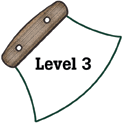
Alaska Science
Key Element A7
A student who meets the content standard should understand how the Earth changes because of plate tectonics, earthquakes, volcanoes, erosion and deposition, and living things (Processes that Shape the Earth).
 |
Alaska Science A student who meets the content standard should understand how the Earth changes because of plate tectonics, earthquakes, volcanoes, erosion and deposition, and living things (Processes that Shape the Earth). |
|
Performance Standard Level 3, Ages 11–14
|
|
|
|
Sample Assessment Ideas
|
|
|
Expanded Sample Assessment Idea
|
|
Procedure Students will:
Reflection and Revision
|
Levels of Performance |
||
|
Stage 4 |
Student model is complete, detailed, and accurately describes the relationship between convection currents within the Earth’s mantle, large-scale motions of the Earth’s interior, and the subsequent effect of the Earth’s surface. Student explanation demonstrates evidence of higher-level thinking and relevant knowledge. There is no evidence of misconceptions. | ||
|
Stage 3
|
Student model is complete, and accurately describes some relationships between convection currents within the Earth’s mantle, large-scale motions of the Earth’s interior, and subsequent effects on the Earth’s surface. Student explanation demonstrates evidence of higher-level thinking or relevant knowledge. Minor misconceptions may be present. | ||
|
Stage 2
|
Student model includes convection currents, large-scale interior movements, or surface changes, but does not demonstrate the relationship between them. | ||
|
Stage 1
|
Student may attempt to construct a model, but the work lacks detail, is incomplete, or inaccurate. Student explanation shows evidence of major misconceptions. | ||
Standards Cross-References
|
||
|
National Science Education Standards The solid Earth is layered with a lithosphere; hot, convecting mantle; and dense, metallic core. (Page 159) Lithospheric plates on the scales of continents and oceans constantly move at rates of centimeters per year in response to movements in the mantle. Major geological events, such as earthquakes, volcanic eruptions, and mountain building result from these plate motions. (Page 160) Land forms are the result of a combination of constructive and destructive forces. Constructive forces include crustal deformation, volcanic eruption, and deposition of sediment, while destructive forces include weathering and erosion. (Page 160) Some changes in the solid Earth can be described as the “rock cycle.” Old rocks at the Earth’s surface weather, forming sediments that are buried, then compacted, heated, and often recrystallized into new rock. Eventually, those new rocks may be brought to the surface by the forces that drive plate motions, and the rock cycle continues. (Page 160) Soil consists of weathered rocks and decomposed organic material from dead plants, animals, and bacteria. Soils are often found in layers, with each having a different chemical composition and texture. (Page 160) Water, which covers the majority of the Earth’s surface, circulates through the crust, oceans, and atmosphere in what is known as the “water cycle.” Water evaporates from the Earth’s surface, rises and cools as it moves to higher elevations, condenses as rain or snow, and falls to the surface where it collects in lakes, oceans, soil, and in rocks underground. (Page 160) Water is a solvent. As it passes through the water cycle it dissolves minerals and gases and carries them to the oceans. (Page 160) Living organisms have played many roles in the Earth’s system, including affecting the composition of the atmosphere, producing some types of rocks, and contributing to the weathering of rocks. (Page 160) The Earth processes we see today, including erosion, movement of lithospheric plates, and changes in atmospheric composition, are similar to those that occurred in the past. Earth history is also influenced by occasional catastrophes, such as the impact of an asteroid or comet. (Page 160) |
Benchmarks The interior of the Earth is hot. Heat flow and movement of material within the Earth cause earthquakes and volcanic eruptions and create mountains and ocean basins. Gas and dust from large volcanoes can change the atmosphere. (Page 73) Some changes in the Earth’s surface are abrupt (such as earthquakes and volcanic eruptions) while other changes happen very slowly (such as uplift and wearing down of mountains). The Earth’s surface is shaped in part by the motion of water and wind over very long times which act to level mountain ranges. (Page 73) Sediments of sand and smaller particles (sometimes containing the remains of organisms) are gradually buried and are cemented together by dissolved minerals to form solid rock again. (Page 73) Sedimentary rock buried deep enough may be reformed by pressure and heat perhaps melting and recrystallizing into different kinds of rock. These reformed rock layers may be forced up again to become land surface and even mountains. Subsequently, this new rock too will erode. Rock bears evidence of the minerals, temperature, and forces that created it. (Page 73) Thousands of layers of sedimentary rock confirm the long history of the changing surface of the Earth and the changing life forms whose remains are found in successive layers. The youngest layers are not always found on top, because of folding, breaking, and uplift of layers. (Page 73) Although weathered rock is the basic component of soil, the composition and texture of soil and its fertility and resistance to erosion are greatly influenced by plant roots and debris, bacteria, fungi, worms, insects, rodents, and other organisms. (Page 73) Human activities, such as reducing the amount of forest cover, increasing the amount and variety of chemicals released into the atmosphere, and intensive farming, have changed the Earth’s land, oceans, and atmosphere. Some of these changes have decreased the capacity of the environment to support some life forms. (Page 73) |
|
Table of Contents | Return to Alaska Native Knowledge Network